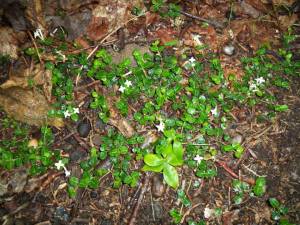I just finished reviewing 4 manuscripts for three different journals and boy is my brain fried. My private reactions ranged from “I can’t wait until this one is published!” to “If I were to use sheet mulch this manuscript would be my first choice.” Anyway, it was the latter manuscript that got me to thinking about what can go wrong with experimental design, which brings up today’s word: thigmomorphogenesis.
This is a great word for those who enjoy figuring out word meanings by deciphering the (usually) Greek or Latin roots. (This exercise also helps you figure out how to pronounce it.) We have “thigmo-” which means touch, “-morpho-” which means appearance, and “-genesis” which means beginning. String them all together and you get the phenomenon seen when plants respond to mechanical stimulation by changing their growth pattern and hence the way they look.

You can easily see examples of thigmomorphogenesis in everyday life. Look at a line of hedge plants where the plants on the end are more susceptible to wind movement and brushing by people, animals or vehicles. They are always shorter, aren’t they? Plants subjected to chronic thigmomorphogenic forces are generally shorter than their neighbors and thicker in girth. (For a longer discussion about how thigmorphogenesis works, you can read my online column.)
How does all of this relate to experimental design? Well, think about what happens if you are testing a product that requires applying it to the leaves of plants once a week. Your treatment plants are touched every week. How can you know that any changes in your experimental plants aren’t due to being touched? The way you eliminate this source of variability is by treating all of the plants the same way. When you are applying the product to the treatment leaves, you apply water (or whatever the solvent is for the product in question) to the control leaves. That way thigmomorphogenesis remains just an interesting tongue-twister and not a fatal design flaw in an experiment.



